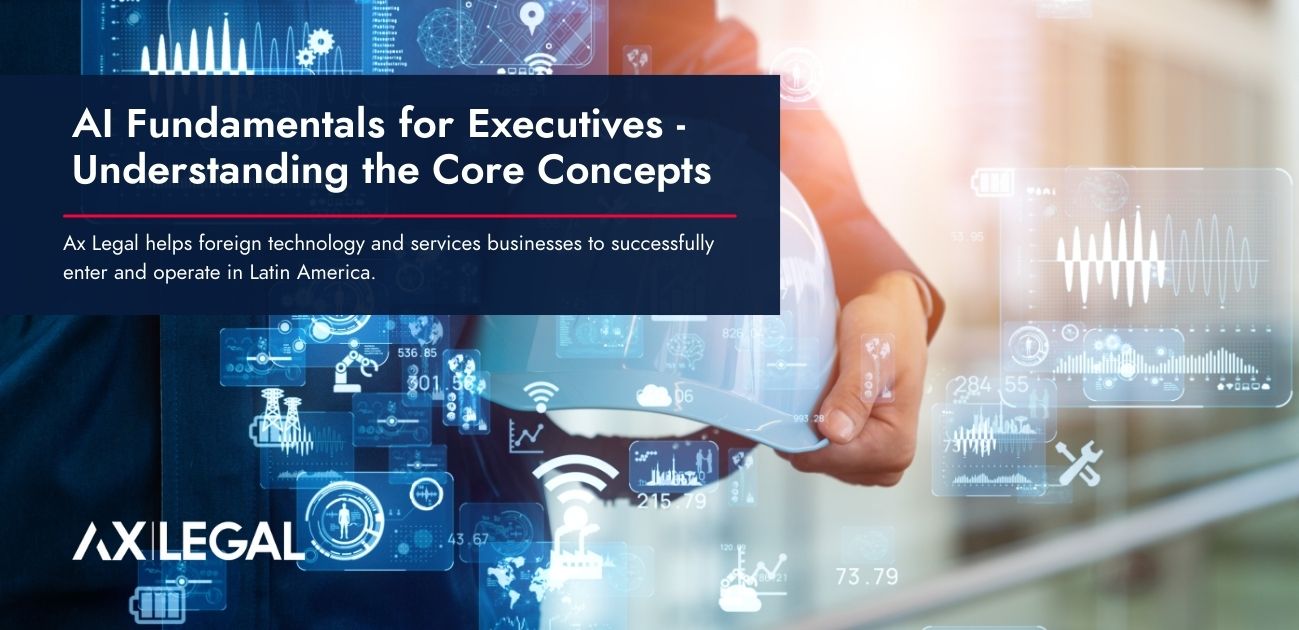AI Fundamentals for Executives – Understanding the Core Concepts
Artificial Intelligence (AI) is no longer just a theoretical concept or science fiction; it’s a powerful technology reshaping industries, economies, and the very fabric of society. In Latin America and across the globe, AI’s rapid adoption is enabling businesses to automate tasks, analyze vast data sets, and make decisions with new levels of precision. This momentum brings great potential for growth, innovation and efficiency, but it also presents complex challenges and responsibilities that demand a strategic, well-informed approach.
While many executives understand the basics of how AI works, there is still a gap in knowledge that make it difficult to discuss in detail. For business leaders, legal, and governance professionals, AI’s rise means more than just keeping pace with technological advances; it’s about understanding the foundational concepts and principles that underpin these systems. These technical aspects – once the domain of data scientists and engineers – now intersect with law, ethics, and business strategy. Yet, navigating AI’s terminology and concepts can be daunting, given the specialized language often involved.
This article is crafted to simplify the core concepts of AI, shedding light on essential technical insights and legal considerations that will empower companies to innovate responsibly. With this knowledge, leaders can engage confidently in policy discussions, make informed decisions, and build trust with stakeholders as they navigate Latin America’s emerging AI landscape.
Core Concepts for executives
Artificial Intelligence
AI does not have a single, universally accepted definition. However, AI, in its simplest form, refers to a system’s ability to perform tasks that typically require human cognitive functions, such as learning, reasoning, and planning.
The concept of AI has evolved over the years, and a useful way to understand it is through the framework that describe AI using two dimensions: thinking versus acting and human versus rational. This results in four distinct approaches:
- Thinking Humanly: Replicates human thought processes like decision-making. Example: IBM’s Watson analyzes medical data to assist in diagnosing conditions, emulating human-like reasoning.
- Thinking Rationally: Uses logic-based rules to simulate reasoning. Example: Prolog-based AI in legal tools applies rule-based logic to analyze cases and suggest solutions.
- Acting Humanly: Aims to create machines indistinguishable from humans in their responses, inspired by the Turing Test. Example: Chatbots like ChatGPT respond conversationally, emulating human-like interactions in customer service.
- Acting Rationally: Focuses on goal-oriented actions and efficiency rather than mimicking humans. Example: Predictive analytics in Amazon’s supply chain optimize inventory management to achieve operational goals.
Today, AI systems emphasizes the creation of rational agents: systems that perceive their environment and take actions that maximize their chances of success. This means that AI doesn’t need to “think” or “act” like us; it simply needs to be an effective and ethical tool for achieving business objectives within its programmed constraints.
Generative vs. Discriminative AI
Generative AI creates new data that resembles the training dataset, making it ideal for content generation, product design, and personalized marketing. For instance, text models like ChatGPT generate human-like responses, while tools like DALL-E create images based on text inputs. This capability opens up innovative applications in marketing and customer engagement, although it also raises challenges around authenticity, especially concerning deepfakes and misinformation.
Discriminative AI, on the other hand, classifies data into predefined categories rather than creating new content. Discriminative models are important for tasks that require high accuracy, like anomaly detection in security systems, medical image classification, and fraud detection in finance. Discriminative AI enhances risk management and decision-making in sectors where precision and reliability are necessary.
Large Language Models and Large Vision Models
Large Language Models (LLMs) are powerful AI models for generating text, translating languages, and handling complex questions. Known for their role in generative chat solutions, such as ChatGPT, Claude, Mistral, and Gemini, it provides tools to enhance customer service, automate content creation, and support multilingual communication.
Large Vision Models (LVMs) specialize in processing visual data, like images and videos. They excel at tasks such as image classification, object detection, and image generation. Tools like MidJourney, DALL-E, and Stable Diffusion synthesize images from text inputs, while video models like HeyGen transform text into lifelike video avatars.
Machine Learning and Deep Learning
At the core of modern AI lies machine learning (ML) – the method through which AI systems “learn” from data without being explicitly programmed for every possible scenario. By identifying patterns in data, ML models can make predictions or decisions that become increasingly accurate over time. Key types include supervised learning for tasks like fraud detection, unsupervised learning to uncover patterns for market segmentation, and reinforcement learning, which optimizes actions based on rewards—vital in robotics and autonomous systems.
A subset of machine learning, deep learning (DL) uses neural networks to process complex, high-dimensional data. These neural networks are inspired by the structure of the human brain, consisting of layers of “neurons” that process information in stages. Particularly effective for image and speech recognition, DL models can identify features for accurate predictions without manual input. However, DL models often operate as “black boxes,” making it hard to trace their decisions, which poses challenges for sectors like finance and healthcare that require transparency.
For businesses, understanding machine learning and deep learning offers a window into AI’s capabilities and limitations. While ML provides powerful tools to analyze patterns and make data-driven decisions, it also underscores the importance of transparency and accountability as companies integrate AI into their operations.
The Role of Data in AI Training
Data is the foundation of AI, enabling models to make accurate predictions and decisions. High-quality, relevant data boosts AI performance, helping models detect trends and correlations. For example, a language model trained on extensive text data can generate human-like responses, while image classifiers identify objects or patterns. Essentially, the better the data, the more effective the AI.
Parameters are adjustable variables within a model, fine-tuned to improve accuracy during training. Complex models, like GPT-4o and NotebookLM, with billions of parameters, require substantial data and computational power but offer deep insights. Effective parameter tuning refines models to minimize errors, making AI systems more reliable. For businesses, balancing data quality with parameter tuning is essential, supporting precise, actionable insights that enhance decision-making to real-world challenges.
Trustworthy AI Principles
As AI becomes embedded in businesses and society, the need for trustworthy AI has never been more important. Trustworthy AI ensures that systems are not only effective but also ethically sound, transparent, and aligned with the well-being of individuals and society. These core principles guide responsible AI development and deployment:
- Human Agency and Oversight: AI should support fundamental rights and enable human oversight, especially in fields like healthcare and finance to prevent potential AI-driven risks.
- Technical Robustness and Safety: AI systems must be resilient to errors, attacks, and unintended consequences, with fallback plans and regular assessments to ensure reliable performance and data integrity.
- Privacy and Data Governance: AI must prioritize user privacy, safeguard data, and enforce strict protocols to prevent misuse and breaches.
- Transparency: Transparency in AI involves making systems explainable and traceable. Business leaders and users alike should be able to understand how an AI system makes decisions, especially in regulated industries.
- Diversity, Non-Discrimination, and Fairness: AI should avoid unfair biases, ensure inclusivity, and deliver fair outcomes, especially in hiring, lending, or healthcare.
- Societal and Environmental Well-Being: Trustworthy AI considers its impact on society and the environment. AI systems should be sustainable, environmentally friendly, and designed with social good in mind. For example, optimizing logistics to reduce emissions.
- Accountability: AI systems should be auditable, with clear channels for reporting and addressing adverse impacts. It means that companies are responsible for their AI applications and have mechanisms for redress if the AI causes harm. By establishing clear accountability frameworks, companies can proactively address risks and maintain public trust.
These principles guide companies in building fair, safe, and transparent AI. For business leaders, adhering to trustworthy AI principles isn’t just about risk management – it’s about building AI solutions that enhance stakeholder trust and contribute positively to the broader community.
Conclusion: The AI-Driven Market and Society
AI is reshaping industries and presenting businesses with unprecedented opportunities to drive growth, streamline operations, and redefine customer engagement. Generative AI has the potential to add $2.6 trillion to $4.4 trillion – annually – to the global economy. Early adopters of these technologies are gaining a formidable advantage, as AI increasingly becomes a driver of productivity, innovation, and market leadership.
As AI becomes more sophisticated, it is increasingly blurring the lines between human and machine-generated content, impacting areas such as news media, education, and social networking. The influence of AI extends to our perceptions of reality itself, as technologies like deepfakes and augmented reality challenge what we recognize as authentic.
However, realizing AI’s full potential requires more than adopting the latest tools; it calls for a deep understanding of AI’s concepts, core principles, legal considerations, and governance frameworks. For companies, this AI-driven shift in society presents both opportunities and responsibilities. While AI can enhance engagement and drive growth, it also brings ethical and regulatory challenges that businesses must navigate carefully to maintain public trust.
As AI continues to redefine industries, businesses have a unique opportunity to lead by example, setting standards for ethical, innovative, and impactful AI applications in society.
Ax Legal helps industrial technology, engineering, and service companies to navigate the legal and commercial aspects of operating their business in Latin America. With deep knowledge of the industrial and natural resource sectors, we provide actionable and practical advice to help streamline our clients’ entries into Latin America, improve how they operate in the region, and to protect their interests.
Over the years, our team of legal and commercial advisors have developed a track record of working with companies of all sizes from Australia, Canada, the U.S., and Europe. The one common factor that connects our clients is that they are leaders in their field, providing innovative technologies and services to the industrial sectors.
To better understand how we can support you in the Region, please contact Cody Mcfarlane at cmm@ax.legal




 Santiago
Santiago Sydney
Sydney Lima
Lima